IN THIS ISSUE
- Grant boosts ability to save plants
- Latest on bald eagle nesting in Georgia
- How downies dine when not at your feeder
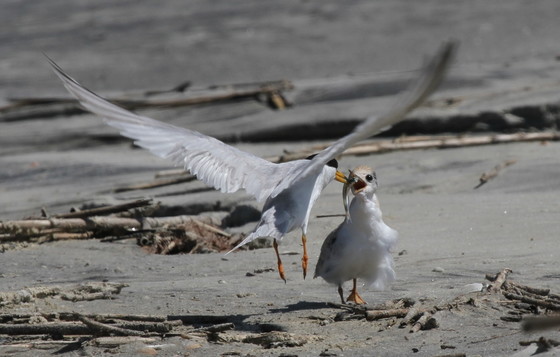 A least tern feeds its nestling on Little Tybee Island. (Tim Keyes/DNR)
Beach-bound for the July Fourth weekend? Keep an eye out for birds.
Georgia’s beaches are not only vacation destinations, they’re top spots for nesting shorebirds and seabirds and for migrating species feeding on flights to the Arctic.
American oystercatchers, Wilson’s plovers and least terns use sites such as Little Tybee Island, St. Catherines Island bar, Cumberland Island and Jekyll Island's southern end. Among other species, black skimmers, royal and sandwich terns, brown pelicans, and gull-billed terns also nest on Georgia beaches and sandbars.
When these birds are nesting, human disturbance poses a significant threat. Shorebirds and seabirds also face risks from predators and high tides. Pets can be destructive, too, killing or scaring birds.
How can you help?
- Avoid posted sites. (Eggs and chicks are camouflaged and easy to overlook.)
- Walk below the high-tide line.
- Back away from any nesting birds you accidentally disturb. Adults frightened from a nest will often call loudly, exhibit distraction displays – such as dragging a wing – to draw predators away and even dive-bomb intruders.
- Enjoy beach birds, but from a distance.
- Leave dogs at home or, if visiting a beach where they are allowed, on a leash.
Top
BIRDING TRAIL HIGHLIGHT: J.F. GREGORY
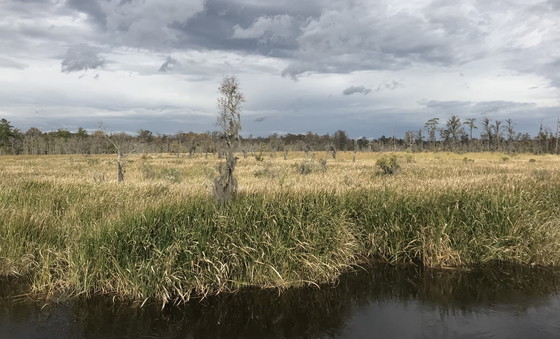 Birding-tower view of the J.F. Gregory Park wetland (Beth Quillian/DNR)
Speaking of birds, if you haven’t been to J.F. Gregory Park in Richmond Hill, it’s worth the trip. Look and listen for birds and other wildlife as you walk a 3-mile trail around the 300-acre wetland, remnant of a rice field that predates the Civil War. There’s also a tower for unobstructed views. Make sure to scan the sky for Mississippi and swallow-tailed kites! Explore Georgia Birding & Wildlife Trails, even via the Go Outdoors app.
Top
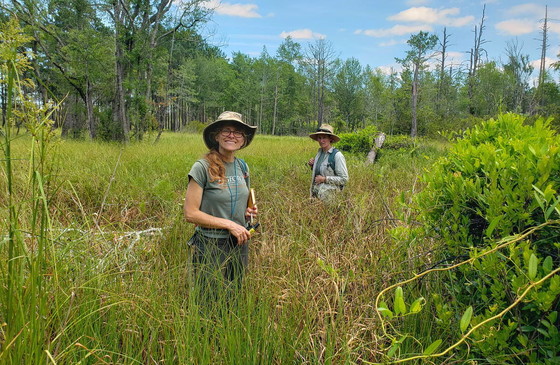 DNR's Lisa Kruse and Stephanie Koontz assess pondberry at Sandhills WMA. (Nathan Klaus/DNR)
DNR staff combed through waist-high wetland meadows at Sandhills Wildlife Management Area last week to track a shrinking stand of pondberry.
Senior botanist Lisa Kruse said the endangered species is a Goldilocks plant: Although found only in wetlands, “It’s really picky about how much water it can take.” At Sandhills in middle Georgia, a depression wetland that was once just right is now holding more water. Which has put the pondberry in peril.
The plan is to assess the population’s size and reproduction, sample tissue for DNA analysis, and collect fruit and stems to grow in botanical gardens, maintaining the genetic diversity and later returning the plants to restored sites at the WMA.
“As the habitat continues to change, we will have the chance to reintroduce the population,” Kruse said.
That, in a nutshell (or a pondberry drupe), is the promise of the nearly $780,000 federal grant awarded a DNR-led partnership to sample, grow and save 14 imperiled plant species. The funding will boost capacity to preserve the plants at the State Botanical Garden of Georgia, Atlanta Botanical Garden and Chattahoochee Nature Center, while spreading that expertise and support to others in the Georgia Plant Conservation Alliance, or GPCA.
Kruse calls the impact “expansive.” And not only for the targeted plants, which vary from pondberry to hairy rattleweed, all federally listed as endangered or threatened.
 Pondberry fruits in the fall (left) and now (left, John Jensen/DNR; right, Stephanie Koontz/DNR)
“The grant is going to fortify GPCA’s main partners and build the diversity and number of botanical gardens that can help preserve rare plants,” she explained, referring to the nationally recognized network of universities, agencies, nonprofits and companies that have combined their clout to conserve plants.
Plants often play second fiddle to efforts focused on recovering rare animal species. But Georgia’s five-year project landed the U.S. Fish and Wildlife Service Recovery Challenge grant through its strong plan to safeguard the 14 species and add Plant Conservation Alliance members who can do the work. Learn more.
CONEFLOWER TRENDING UP
More good news for plants: The recovery of smooth purple coneflower is going so well the U.S. Fish and Wildlife Service wants to downlist it from endangered to threatened under the Endangered Species Act.
The proposal cites partnerships that helped restore Echinacea laevigata, also known simply as smooth coneflower, across its range in Georgia, the Carolinas and Virginia.
When listed as endangered in 1992, the surviving 21 populations were vulnerable and unstable. Thanks to conservation efforts and the discovery of more sites, the number of populations is up to 44, with 16 on protected lands and rated healthy.
Check out this GPCA poster on a quarter-century of coneflower conservation.
Top
 Bald eagle carrying nesting material (Jenny Burdette Photography/GNPA)
While the pandemic didn’t disturb bald eagles nesting in Georgia, it did ground most nest survey flights for the iconic raptors this year.
Six coastal counties were surveyed by helicopter in the winter and spring. Another 12 nests were monitored on foot. But COVID factors nixed southwest Georgia flights. (The coast – the state’s eagle-nesting hotspot – is flown each year, while surveys of the Coastal Plain and Piedmont and the mountains alternate years.)
On the bright side, the coastal counties reported nesting totals almost identical to 2020 and in line with annual averages. Those 71 occupied nest territories fledged 81 young, and 55 fledged at least one eaglet. Survey leader Dr. Bob Sargent said six new occupied nest territories were found on the coast, plus three elsewhere in the state.
All told, the 83 territories monitored this year fledged 94 young, or 1.5 young per nest, which is the long-term average in Georgia.
What isn’t average: Sargent is seeing more eagles nesting closer to areas where there’s more human activity. As a rule of thumb, most eagle pairs in Georgia avoid nesting near man-made structures and human-associated disturbances.
While there have been exceptions, Sargent said 2021 featured increased reports of eagles nesting "or exhibiting behaviors associated with the establishment of nesting territories on small lakes in the midst of extensive development.” This was especially the case on the north edge of metro Atlanta and the margins around Savannah.
Have bald eagle numbers soared to the point the best territories are taken, and birds are nesting in areas they once shunned?
The U.S. Fish and Wildlife Service estimates there are 316,000 bald eagles in the lower 48 states, a fourfold increase since 2009. Georgia nest totals grew from about 100 in 2007 to 200-plus in 2015.
Florida, home to more than 1,500 territories, is documenting eagles nesting in unexpected places, including near urban areas and on electrical towers and other man-made structures.
“Perhaps more eagles, especially those classified as floaters because they sort of hang out waiting for territories to become available, are discarding the rule and building homes closer to us,” Sargent said.
NEST NUMBERS
- Six coastal counties: 71 occupied nest territories, with 55 fledging at least one eaglet (78 percent success rate, which is average), 81 young fledged (1.5 per successful nest – average) and 1.1 young fledged per occupied nest territory (average). Six new occupied nest territories found.
- Monitored on foot: 12 occupied nest territories, with nine fledging at least one eaglet (75 percent success rate), 13 young fledged (1.4 per successful nest) and 1.1 young fledged per occupied territory. All of these stats are average for the state. Three new occupied territories found.
- Totals: 83 occupied nest territories, with 64 fledging at least one eaglet (77 percent success rate), 94 young fledged (1.1 per occupied territory) and 1.5 young fledged per successful nest. Again, these stats are average.
Top
 Downy woodpeckers foraging (left, Terry W. Johnson; right, Todd Schneider/DNR)
By TERRY W. JOHNSON
The woodpecker we are most likely to see in Georgia is the downy. Although those who feed birds are familiar with how downies dine during their brief visits to feeders, the feeding behavior of our smallest woodpecker is very different when foraging in the wild.
For example, did you know that more than 75 percent of the downy woodpecker's diet is comprised of the eggs, larvae and adults of a variety of invertebrates such as bark beetles, tent caterpillars, ants, spiders, scale insects, snails, fruit borers and even flying insects like moths and mayflies?
Plant material makes up most of the rest of the bird's diet, from the berries of flowering dogwood, Virginia creeper, sumac and poison ivy to acorns.
How this plays out in the wild, whether it’s a downy looking for grubs in goldenrod galls or staking claim to a preferred tree canopy for beetle larvae, is fascinating. …
Read the rest of Terry’s column for insights into how downies feed.
Terry W. Johnson is a retired DNR program manager and executive director of TERN, the Wildlife Conservation Section’s friends group. Check out past columns, his Backyard Wildlife Connection blog and Terry's book “A Journey of Discovery: Monroe County Outdoors.” His columns are also featured on DNR’s blog, under the Conservation tab. Permission is required to reprint a column.
Top
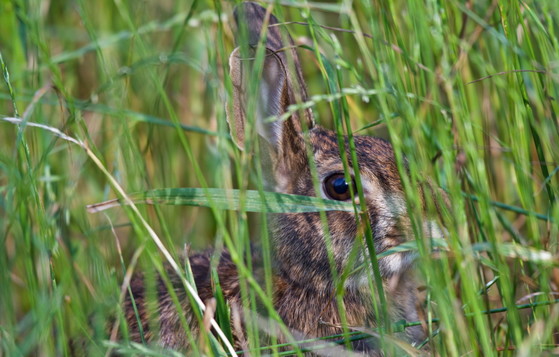 RHDV2 is a threat to domestic rabbits and wild ones, like this cottontail. (Guerry Doolittle/GNPA)
Rabbit hemorrhagic disease, highly contagious and usually fatal to rabbits, has been confirmed in domestic rabbits at a Cobb County site. Also known as RHD (the current outbreak is a viral subtype called RHDV2), the disease has spread across the western U.S. and Canada and much of Mexico, killing scores of cottontails and jackrabbits, primarily in the southwest. Although no infected wild rabbits have been found farther east than Texas, Georgia's case is the second involving domestic rabbits east of the Mississippi River. Florida reported the first case in January. RHD only infects rabbits, jackrabbits and pikas, not humans or other animals.
Scores of dead mussels floating on Lake Sinclair raised eyebrows, but none should miss these mollusks. The clumps called “popcorn” mostly included Asian clams, widespread in the U.S. but not native. DNR aquatics biologist Matthew Rowe said that while such die-offs are often linked to hot water temperatures, the cause at Sinclair is unclear, although boom and bust cycles are common for Asian clams.
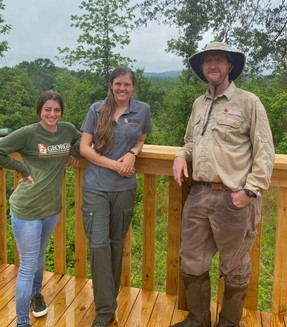
A DNR Wildlife Viewing Grants project at Prater’s Mill Historic Site is halfway home, with one of two viewing platforms built on a nature trail near the historic Whitfield County mill. Even better, DNR staff and project leaders checking a proposed trail section for wildlife highlights found state-tracked southern showy skullcap in the path, requiring a slight route change but adding a wild and welcomed feature. (At right, a rain-soaked DNR crew takes a break on the Prater's Mill platform.)
The effort to eradicate tegus from the wild in Toombs and Tattnall counties added arrays of game cameras rotated among sites to try and detect the invasive lizards this summer. But the public’s help is still critical: Report tegus, dead or alive, at gainvasives.org/tegus, (478) 994-1438 or gainvasives@dnr.ga.gov.
The Conservation Fund bought 6,154 acres along the Altamaha River from Rayonier, increasing an already impressive conservation corridor anchored by the massive river. The nonprofit’s plans for Beards Creek Forest in Long County include maintaining sustainable forestry and traditional uses such as hunting, while restoring the site’s hydrology and longleaf pine ecosystem to benefit rare wildlife.
What to do when you bump into a bear, figuratively speaking? Whether in your backyard or on the back 40, here is some Bearwise advice on handling a close encounter with one of Georgia’s more than 4,000 bruins.
When COVID-19 spurred more people to get outdoors last year, some wondered if the interest would stick. So far, so good, according to Georgia hunting and fishing license sales from Jan. 1-June 15 that show the pandemic surge – a 24-percent jump from 2019 to 2020 – eased off only about 5 percent in 2021 and remains strong.
Top
|
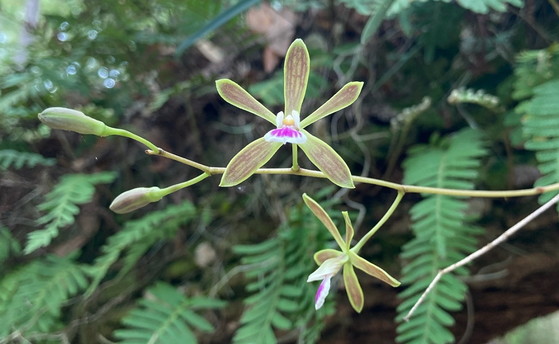 Florida butterfly orchid blooming on Cumberland Island (Doug Hoffman/NPS)
Florida butterfly orchid, previously known only from the Bahamas, Cuba and as far north as Florida’s Putnam County, has been found on Cumberland Island, the first time the species has been documented in Georgia. Cumberland resident Jennifer Candler spotted the orchid growing on a live oak last fall on the island’s north end; the identification was confirmed when the plant flowered recently.
Georgia has only three known populations of sandhill lily. For four years at a Coffee County site, DNR, The Nature Conservancy and others have been applying prescribed fire and putting deer-proof wire cages around the lilies (also called pineland lily), measures that have helped increase the population.
Have you seen the statewide winners in Georgia’s 31st annual Give Wildlife a Chance Poster Contest? Here’s a DNR and State Botanical Garden of Georgia gallery and a quick video of each age category’s first- through third-place posters, chosen from about 1,100 kindergarten through fifth-grade students.
Top
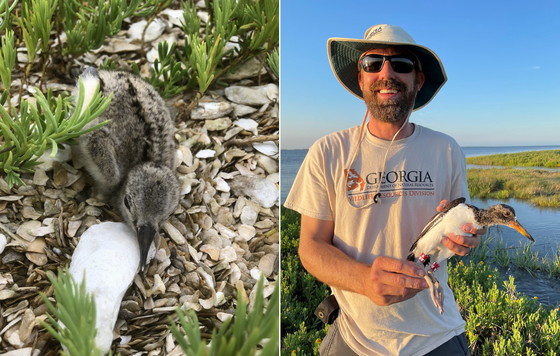 A small oystercatcher chick and an older one banded last month (left, Tim Keyes/DNR; right, Abby Sterling/Manomet)
Up-and-coming American oystercatchers on the Georgia coast include this small chick on Satilla River Marsh Island and one of the first young oystercatchers banded this year. DNR's Tim Keyes, pictured, said predators and flooding have been a challenge for the rare shorebirds but the nesting season "still could turn out OK.”
Georgia sea turtle strandings – sea turtles found dead, injured or ill on beaches – are the lowest seen in recent years. Halfway through 2021, 47 stranded turtles have been documented compared to 50 during the same period last year and the six-year high of 93 in 2017. The data helps scientists monitor populations and threats. Real-time updates on Georgia strandings and sea turtle nesting.
Florida has reported 811 manatee deaths through June 18 this year, a nearly 150 percent increase over the previous five-year average and more than all that died in the state (637) in 2020. One primary cause is the loss of seagrass in the Indian and Banana River lagoons and other areas around Brevard County, which is also the winter home to many manatees that migrate to Georgia in summer.
Top
 Learning about trees at the Georgia Teacher Conservation Workshop (DNR)
Nineteen educators were schooled on conservation at the 16th annual Georgia Teacher Conservation Workshop. Led by DNR and the Georgia Forestry Commission, the hands-on training designed to support curricula and student projects covered topics varying from sustainable forestry to prescribed fire.
On the coast last month, 16 teens from four states learned about ornithology, ecology, wildlife research and conservation careers in DNR’s Camp TALON. Each day featured a deep dive into birding, with field trips led by experts to sites such as Little St. Simons and Sapelo islands.
The Western Hemisphere's largest nighttime roost for Hudsonian whimbrels, a shorebird species in decline, has been found. A just-published study revealed that more than 19,000 whimbrels – almost half of the Atlantic Coast population – use a sand spit island south of Charleston, S.C., as a staging area during spring migration.
Conservation kudos to 2021 Forestry for Wildlife partners CatchMark Timber Trust, Georgia Power and Weyerhaeuser. Gov. Brian Kemp recognized the three corporate forest landowners for their stewardship and management benefiting wildlife in the DNR program for Georgia owners of 10,000 or more acres.
Top
 Shan Cammack and Burner Bob talk prescribed fire with youth (The Longleaf Alliance)
Burner Bob teamed with The Longleaf Alliance and DNR’s Shan Cammack and Garrett Anderson on a video profiling for young audiences the benefits of prescribed fire. Burner Bob, by the way, is the Longleaf Alliance’s mascot for “good fire.”
In case you missed it, Georgia lawmakers unanimously approved a resolution urging Congress to pass Recovering America’s Wildlife Act. The legislation would provide $1.4 billion from existing revenues – no new taxes involved – to help state and tribal agencies prevent thousands of animal and plant species from becoming endangered, work that would have an estimated $3.3 billion economic impact.
Names in the news: When it comes to banding birds, Anne Armstrong is a super volunteer. Since her first day volunteering at Joe Kurz Wildlife Management Area in 2008 through a banding stint Saturday at Panola Mountain State Park, the Macon resident has logged more than 1,440 hours banding birds at the two sites, part of monitoring led by Georgia Important Bird Areas Coordinator Charlie Muise. Game warden Brock Hoyt received the DNR Law Enforcement Division's Torch Award for 2021. A warden since 2018, Hoyt is assigned to Fulton County. Former Georgia Conservancy trustee and board Chair Clay Long, 85, died May 29. For his work including overseeing the conservancy's Blueprints for Successful Communities program, the nonprofit honored the Atlanta attorney and community leader as its Distinguished Conservationist in 2005. Casey Corbett, who teaches fish and wildlife management at Ogeechee Technical College, has been named Georgia’s top technical college instructor. On receiving this year's Rick Perkins Award for Excellence in Technical Instruction, Corbett credited the late state Sen. Jack Hill, a Reidsville native who she said “had a front-row seat watching me grow up and knew the passion I had for wildlife.”
WHAT YOU MISSED ...
In the previous Georgia Wild:
- An "Out My Backdoor" double-shot
- Die-off haunts manatee migration
- More zebra mussels trigger warnings
- Plus: a Big Day record, trillium finds, yard owls
Top
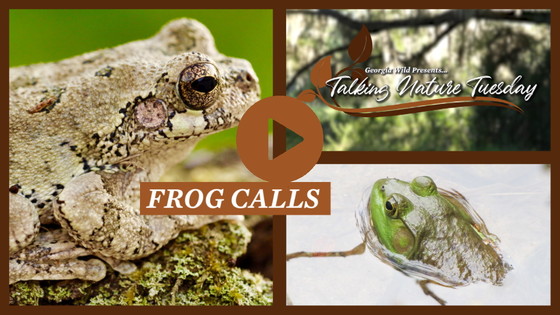 "Talking Nature Tuesday: Summer Frog Calls," DNR
"Hummingbirds are not declining," interview with DNR's Todd Schneider and TERN Executive Director Terry W. Johnson, WMAZ-TV (Ch. 13, Macon)
Nesting sea turtle on Little St. Simons Island (Instagram), special to DNR
"Report Invasive Tegus," DNR
Freeing an entangled fox, solving a bats-in-the-attic issue and reuniting a fawn and mom, DNR Urban Wildlife Program
Field day explores how sustainably managed forests benefit birds, Georgia Forestry Foundation
"Osprey and Owl," (Savannah) Landings nest cam, Cornell Lab
"Wildlife Wednesday: Brown Snake," DNR
"Birding while Biking with Dudley Edmondson," Minnesota DNR Nongame Wildlife Program
Top
"Federal grant to help grow and save 14 rare Georgia plants," Associated Press. Also: WGUA-FM (Athens), Yahoo! News, Coosa Valley News and others.
"Smooth coneflower makes comeback in Georgia, Southeast," Georgia Recorder
"Discovery brings glimmer of hope to declining whimbrels," Manomet
"Red knots in steepest decline in years," The New York Times
"Florida enacts sweeping law to protect wildlife corridors," National Geographic
"Flint RiverQuarium joins ASU, UGA in mussel project," The Albany Herald
"Georgia purchase of pristine Ceylon tract on track," Capitol Beat
"Rayonier sells land to nonprofit for conservation," Jacksonville Business Journal. Others via AP.
"Casual sighting leads to endangered bat discovery in Asheville," U.S. Fish and Wildlife Service
"Kemp, DNR leaders honor Forestry for Wildlife partners," Outdoor News Daily
(+video) "Snake sightings reported as summer heats up," WJBF-TV (Ch. 6, Augusta). Related: "Killing non-venomous snakes illegal in Georgia" (WMAZ-TV, Ch. 13, Macon)
"Why North Atlantic right whales are smaller now," Canadian Broadcasting Corp. Also: Smithsonian.
"NOAA sets framework to reduce right whale entanglements," Vineyard Gazette, Edgartown, Mass.
"Right whale disentangled off New England coast," WOKQ-FM (97.5, Dover, N.H.)
"Feds raise protections for whales, but sea turtles may suffer," SaportaReport. Related: WSB-TV (Ch. 2, Atlanta).
"National natural landmark protects rare species," The Atlanta Journal-Constitution
"Fitzgerald, Americus students among poster contest winners," Yahoo! News (from The Albany Herald)
(+audio) "Experts: slow sea turtle nesting no cause for concern," Georgia Public Broadcasting
"Game cam set-ups expand tegu removal," The (Vidalia) Advance. Also: Savannah Morning News, Ag Information Network, WJCL-TV (Ch. 22, Savannah), Moultrie Observer and others.
(+audio) "S.C. announces ban on tegus, new rule for pet owners," The State (Columbia, S.C.)
"FWC helps tag nearly 150 tegs, iguanas," Florida Fish and Wildlife Conservation Commission
"After years of detecting land mines, heroic rat hangs up sniffer," NPR
"Rabies scare just raccoons drunk on crab apples," The Chicago Tribune
CREDITS:
Masthead: Coosa (or Mohr’s) Barbara’s buttons (Alan Cressler)
Top
|